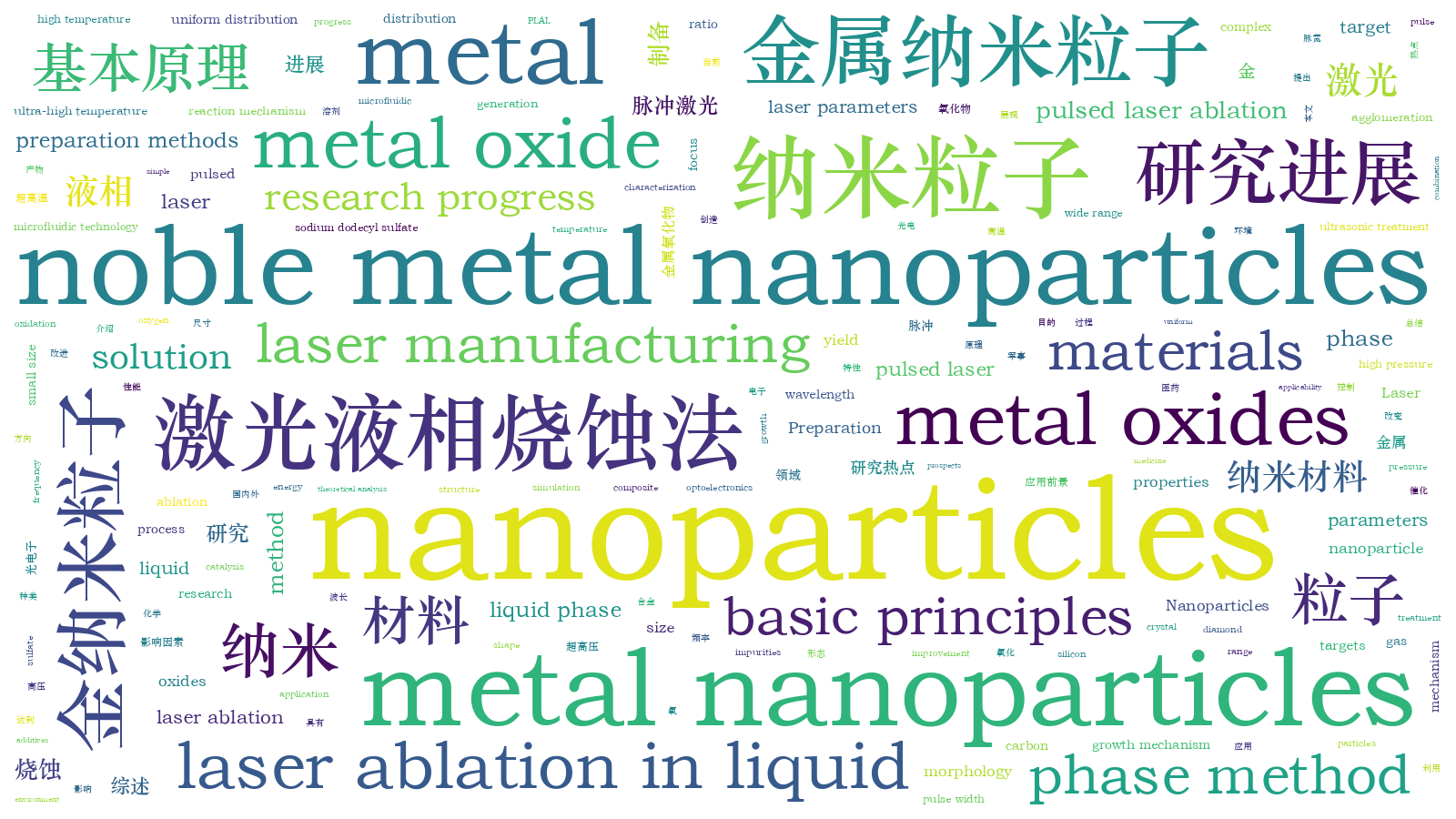激光液相烧蚀法制备纳米粒子研究进展  下载: 1645次封面文章
下载: 1645次封面文章
Significance Because of their special chemical properties, nanoparticles have a wide range of application prospects in optoelectronics, catalysis, medicine, military, and other fields. Researchers have developed many methods for preparing nanoparticles, such as solid phase method, liquid phase method, and gas phase method. These methods all have some shortcomings. For example, the liquid phase method is easy to introduce impurities difficult to be removed, the gas phase method has high costs and harsh conditions, and the solid phase method yields particles with uneven distribution and easy agglomeration. Different from these traditional preparation methods, pulsed laser ablation in liquid (PLAL) can create an ultra-high temperature and ultra-high pressure environment in the liquid, which provides a possibility to prepare nanoparticles that are difficult to be prepared under conventional conditions. It does not need to build complex experimental setups or add various catalysts. The morphology and size of the nanoparticles can be controlled by changing the parameters such as the wavelength, pulse width and frequency of laser and the type of solvents and target materials.
Progress At present, there are four major types of nanoparticles prepared by PLAL: metal nanoparticles, metal oxide nanoparticles, alloy nanoparticles, and non-metal nanoparticles. Metal nanoparticles mainly include noble metal nanoparticles and active metal nanoparticles. The chemical properties of noble metals are stable and the corresponding nanoparticles are easily prepared. Therefore, researchers are more inclined to prepare nanoparticles with a small size and a uniform distribution by controlling different parameters. However, active metal nanoparticles easily react with oxygen atoms in the solution to form metal oxide nanoparticles. To address this problem, researchers try to inhibit the oxidation of active metal nanoparticles by adding surfactants (sodium dodecyl sulfate, hexadecyl trimethyl ammonium bromide) or polymers to the solution. Some progress has been achieved, but the generation of metal oxide nanoparticles is inevitable. How to prepare highly active metal nanoparticles in the solution is still a difficulty for researchers. When metal oxide nanoparticles are prepared, the methods can be generally divided into two types: (1) with metal oxides as the targets, the metal oxide nanoparticles are produced by pulsed laser in the solution; (2) with pure metal as the target, the nanoparticles react with the solution to obtain the corresponding metal oxide nanoparticles. In addition, there are many types of oxides for the same metal. During the laser ablation process, metal oxide nanoparticles with different crystal forms or valence states may be produced in the solution. How to prepare a single type of metal oxide nanoparticle in the solution remains a question. Currently, most alloy nanoparticles prepared by PLAL are composed of two noble metals, or one noble metal and one active metal. Although alloy nanoparticles containing two active metals have been prepared, the products still contain some metal oxides or hydroxide nanoparticles. It is also found that alloy nanoparticles with a certain molar ratio can be prepared by adjusting the ratio of two metal elements in the alloy target. The non-metal nanoparticles prepared by PLAL mainly focus on carbon and silicon that generally do not react with the solution, so non-metal nanoparticles with special morphology can be prepared by adjusting energy, wavelength, and other parameters. Taking carbon as an example, graphene sheets or diamond nanoparticles can be prepared by PLAL. In addition to the above two materials, attempts have been made to obtain some other non-metal nanoparticles by PLAL.
Conclusions and Prospects Compared with the traditional nanoparticle preparation methods, PLAL has simple operation and strong applicability. In some cases, the size and structure of nanoparticles can be controlled by adjusting the laser parameters and other factors. With the increasing demand for nanomaterials, PLAL will be more widely used. However, PLAL also has some room for improvement, such as the low yield of nanoparticles. Researchers have taken a variety of measures to increase the yield of nanoparticles, such as changing the target shape, combining PLAL with microfluidic technology or ultrasonic treatment technology. Although the yield of nanoparticles has been increased, it can not meet the requirements of industrial production. Moreover, the preparation of pure metal nanoparticles by PLAL is still a challenge. Although many kinds of additives or solvents have been added, the desired results have not yet been achieved, which still needs much work. Furthermore, it is also an important research direction to combine PLAL with other nanoparticle preparation methods to prepare composite nanoparticles with excellent properties. In addition, PLAL has been applied to the preparation of nanoparticles for decades. Due to the complex reaction process, numerous factors affecting the morphology of nanoparticles, and a lack of effective characterization methods, the research on the growth mechanism of nanoparticles progresses slowly. In recent years, many researchers have put forward their own theoretical analysis in combination with some simulation methods, but the detailed reaction mechanism has not been conclusive until today. Therefore, researchers should focus on the basic principles of PLAL to provide a theoretical basis for the preparation of pure metal nanoparticles.
陈永义, 鲍立荣, 汪辉, 宁政, 钟贤东, 曹金乐, 沈瑞琪, 张伟. 激光液相烧蚀法制备纳米粒子研究进展[J]. 中国激光, 2021, 48(6): 0600002. Yongyi Chen, Lirong Bao, Hui Wang, Zheng Ning, Xiandong Zhong, Jinle Cao, Ruiqi Shen, Wei Zhang. Research Progress in Preparation of Nanoparticles by Laser Ablation in Liquid[J]. Chinese Journal of Lasers, 2021, 48(6): 0600002.







